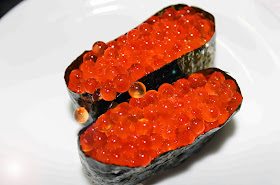Roe (/roʊ/) or hard roe is the fully ripe internal egg masses in the ovaries, or the released external egg masses of fish and certain marine animals, such as shrimp, scallop and sea urchins. As a seafood, roe is used both as a cooked ingredient in many dishes and as a raw ingredient. The roe of marine animals, such as the roe of lumpsucker, hake and salmon, is an excellent source of omega-3 fatty acids. Roe from a sturgeon or sometimes other fishes is the raw base product from which caviar is made.
In the United States, several kinds of roe are produced: salmon from the Pacific coast, shad and herring species like the American shad and alewife, mullet, paddlefish, American bowfin, and some species of sturgeon. Shad, pike and other roe are sometimes pan-fried with bacon. Spot Prawn roe (hard to find) is also a delicacy from the North Pacific. Flounder roe, pan-fried and served with grits is popular on the Southeastern coast.
Makes ~20 artificial salmon eggs
INGREDIENTS:
1 g sodium-alginate powder
1 g gum arabic powder
1 g κ-carrageenan powder
22 g calcium chloride
1 g guar gum powder
16 g (20 mL) vegetable oil
Water
β-carotene†
Red or yellow food coloring‡
Straw (7 mm diameter)
Syringe (1.0–2.5 mL) with needle
NOTE: †YOU CAN USE A β-CAROTENE SUPPLEMENT.
‡ IF YOU DON’T HAVE THE FOOD COLORING, YOU CAN USE TEA OR COFFEE.
PREPARATION PROCEDURE:
1) Make 100 g 1 wt% sodium-alginate solution (Hint 1), 100 g 1 wt% gum arabic solution (Hint 1), 100 g 1 wt% κ-carrageenan solution (Hint 1), 100 g 2 wt% calcium-chloride solution, and 100 g 20 wt% calcium-chloride solution (Hint 2).
2) Add red or yellow food coloring to the 2 wt% calcium-chloride solution to obtain a light-orange color, then dissolve guar gum in it.
3) Dissolve β-carotene (about 0.5 g) in the vegetable oil for a deep-orange color.
4) Pour 30 g 1 wt% sodium-alginate solution, 20 g 1 wt% gum arabic solution, 20 g 1 wt% κ-carrageenan solution (1), and 20 mL water into a cup. Combine the solutions by mixing well with a stirring rod.
5) Pour 100–150 g water into another cup.
6) Pour 50 g 20 wt% calcium-chloride solution into a third cup.
7) Poke syringe needle into a straw at about 2 mm from one end.
8) Draw colored vegetable oil (3) into the syringe, and suck the guar gum–calcium-chloride solution (2) into the straw, with the syringe needle attached at the bottom.
9) Attach the syringe to the needle in the straw (8).
10) Drop the mixture in the straw (9) into the mixed solution of sodium alginate, gum arabic, κ-carrageenan and water (4), injecting the colored vegetable oil in the syringe into the center of drop (9).
11) Move the drop (10) to the cup with water (5) using a spoon, and then move it into the cup with the calcium-chloride solution (6). Soak for 30 mintes then remove.
Cooking Tips:
1) The solute dissolves easily in hot water.
2) One g solute plus 99 g water becomes 1 wt% solution, and 2 g solute plus 98 g water and 20 g solute plus 80 g water become 100 g 2 wt% and 20 wt% solution, respectively.
Watch related videos on this recipe:
How to make salmon roe ikura
How to Make Traditional Ikura (Roe)
Do you want more recipe? Next time try this one... Agar Agar Spaghetti Recipe- Molecular Gastronomy Recipes
Learn about the different uses of agar and xanthan gums at... Uses of Hydrocolloids in Cooking and Food Products

No comments:
Post a Comment